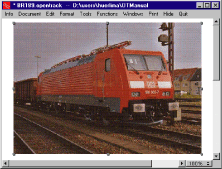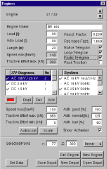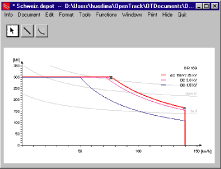Railway Simulation
  |
Diese Seite ist auch auf Deutsch verfügbar. |
  |
Cette page est disponible en Français. |
 |
Questa pagina è disponibile in Italiano. |
 |
Esta página está también disponible en Español. |
Contents
- News / Events
- Introduction
- Data
- Simulation
- Headway Calculation
- Screenshots
- Outputs
- OpenTrack API
- Partners and customers
- Documents / downloads
- Videos
- Further information
News
| Date: | News: |
| January 2024 | OpenTrack is ready for Apple Silicon, the new generation of ARM based CPU's developed by Apple. The new Mac Pro Version of OpenTrack is designed to run natively on Apple Silicon (e.g. on M2 Pro, M3 Max, etc.). |
Events
| Date: | Location: | Event: |
| August 12 - 14,2025 | Auckland (New Zealand) | Plateway at CORE (Conference on Railway Engineering) |
| August 14 - 15, 2025 | Auckland (New Zealand) | OpenTrack User Group Meeting |
The last OpenTrack user workshop was held in Zurich from the 12 to 14 September 2019 at the Swiss Federal Institute of Technology (ETH Zurich, ETHZ). In the user workshop section of this page you will find all the presentations.
Introduction
OpenTrack began in the mid-1990s as a research project at the Swiss Federal Institute of Technology. The aim of the project Object-Oriented Modeling in Railways, was to develop a catalyst for practical economic solutions to complex railway technology problems.
Today, the railway simulation tool OpenTrack is a well-established railway planning software and it is used by railways, the railway supply industry, consultancies and universities in different countries.
OpenTrack allows to model, simulate and analyze the following types of rail systems:
- High speed rail
- Heavy rail / Intercity rail
- Commuter rail systems
- Heavy haul freight
- Mining railway systems
- Metro / Subway / Underground systems
- Light rail (LRT)
- Tram / Streetcar systems
- People mover systems
- Rack railways / Mountain railways
- Maglev (magnetic levitation) systems (e.g. Transrapid)
OpenTrack supports the following kinds of tasks:
- Determining the requirements for a railway network’s infrastructure
- Analyzing the capacity of lines and stations
- Calculation of minimum headways (headway calculation), e.g. using the OpenTrack tool Headway Calculator
- Rolling stock studies (for example, future requirements)
- Running time calculation
- Timetable construction; analyzing the robustness of timetables (single or multiple simulation runs, Monte-Carlo simulation)
- Evaluating and designing various signaling systems, such as discrete block systems, short blocks, moving blocks, LZB, CBTC (communication-based train control), ATP, ATO, ETCS Level 1, ETCS Level 2, ETCS Hybrid Train Detection, (former ETCS Level 3), PTC (Positive Train Control)
- Analyzing the effects of system failures (such as infrastructure or train failures) and delays
- Calculation of power and energy consumption of train services
- Simulation of railway power supply systems (using OpenPowerNet)
Data
Network data
OpenTrack describes a railway network in special graphs called double vertex graphs. A user can edit the network’s topology graphically. Every element of the graph holds various attributes. An edge, for example, holds its length, the gradient, the maximum speed for different train categories and much more. A user can create and manage objects for edges and vertices, and also signals, switches, stations and routes. The following figure shows part of a topology.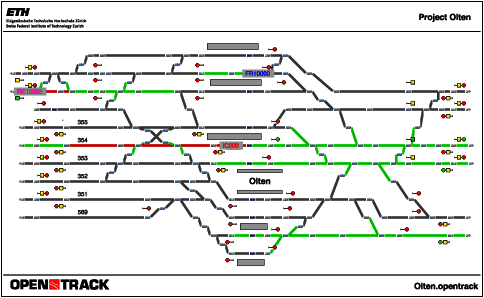
Example of a station (Olten, Switzerland). This graphic is also available as a PDF document.
Rolling stock data
OpenTrack stores each locomotive’s technical characteristics, including tractive effort/speed diagrams, load, length, adhesion factor, and power systems. A database organizes locomotives into groups called depots. A simulated train uses one or more locomotives from a depot together with a number of passenger or freight cars (carriages or wagons). Trainsets are also organized in a database.Timetable data
The timetable database stores information for each train at each station, including arrival and departure times, minimal stop time, and connections to other trains.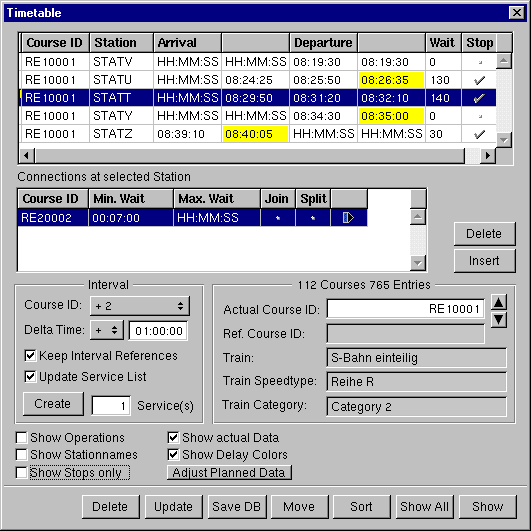 |
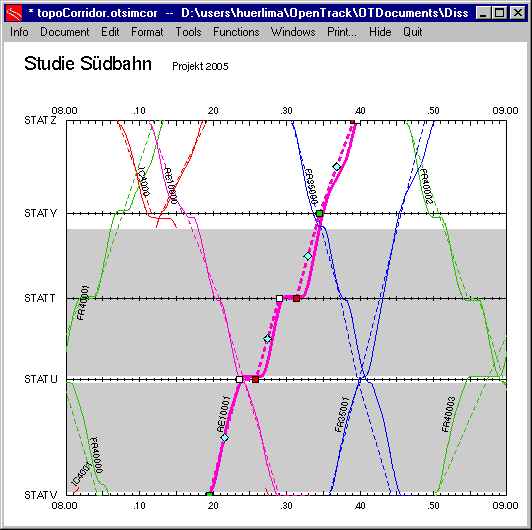 |
The user can edit the timetable data either in textual form (left window) or directly within the train graph by using the mouse (right window) (See also: video section).
A user can compare timetable and actual data either in a table or directly in the train graphic.
Interfaces
OpenTrack offers interfaces to general data formats (such as ASCII and XML) and to some railway-specific formats (including FBS, Protim, Simu VII and others).
OpenTrack also supports railML, the XML-based standard format for the exchange of railway data. Download the railML product sheet (PDF-File, 800 kB).
| Timetable data | ||
| railML (Versions 1.0 and 2.2) | ||
| ASCII | ||
| MS Excel | ||
| OpenTrack ASCII | ||
| OpenTrack XML | ||
| Viriato (via railML) | ||
| FBS (via railML) | ||
| OpenTimeTable (via railML) | ||
| Simu VII (IBS GmbH) | ||
| UK Planning Inferface Format (.PIF-Format, Protim) | ||
| SimWalk (via railML) |
| Infrastructure data | ||
| railML (Versions 1.0 and 2.2) | ||
| ASCII | ||
| MS Excel | ||
| Google Earth (station data) | ||
| OpenTrack ASCII | ||
| SBB ZLR | ||
| Siemens Infrastructure Format | ||
| ETC Infrastructure Format | ||
| SIMON (ÅF-Industriteknik) | ||
| Infraspeed Infrastructure Format | ||
| Bentley Rail Track |
| Rolling stock data (tractive effort/speed diagrams) | ||
| railML (Versions 1.0 and 2.2) | ||
| OpenTrack ASCII | ||
| SimWalk (via railML) |
Simulation
The following figure shows how the simulation tool works. Predefined trains run according to the timetable on a railway network. During the simulation, OpenTrack calculates train movements under the constraints of the signaling system and timetable. After a simulation run, OpenTrack can analyze and display the resulting data in the form of diagrams, train graphs, occupation diagrams and statistics.OpenTrack handles single simulation runs as well as multiple simulation runs where random generators produce different initial delays and station delays.
Animation of the simulation
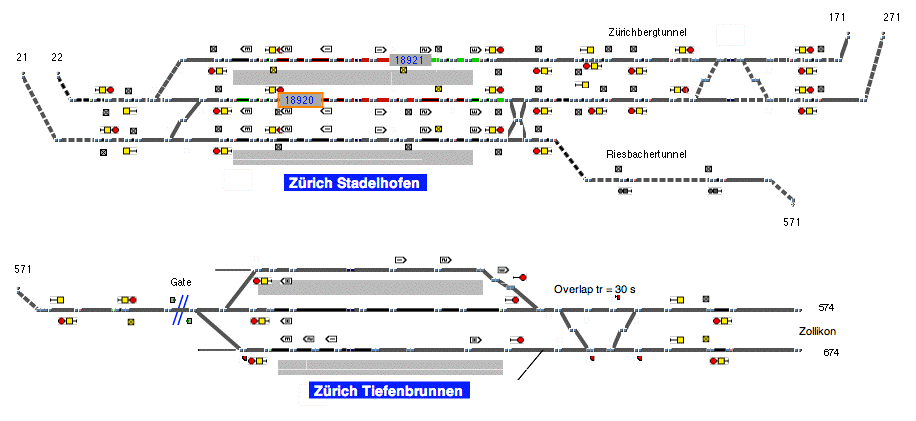
Screenshot of OpenTrack during the simulation. The video can be downloaded.
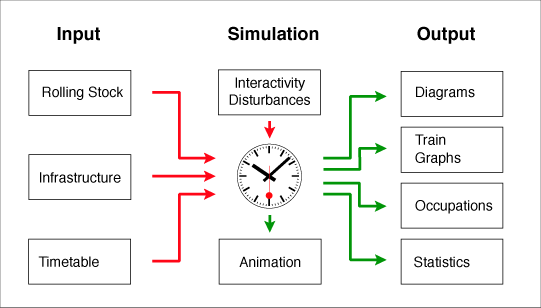
The modules of the simulation (this graphic is also available as a PDF document)
During the simulation, trains try to obey the given timetable. The differential equations for speed and distance are the basis for calculating a train’s movement. The signaling system of the railway network poses constraints. Occupied tracks and restrictive signal aspects may impede a train’s progress.
During the simulation, every train continuously stores its speed, acceleration, position, power consumption and other data. This data can be evaluated after the simulation.
The user can watch the simulation in an animation mode, which shows the trains running and lets the user analyze occupied tracks, reserved tracks and signal aspects..
Headway Calculator / Headway Calculation
Based on a number of input parameters, the headway calculator computes the minimum headway between two trains and is able to identify the critical block section. The two trains may vary in type (e.g. intercity, commuter, freight, etc.), route and stopping pattern. The headway calculation works for fixed block (discrete block), moving block and CBTC systems.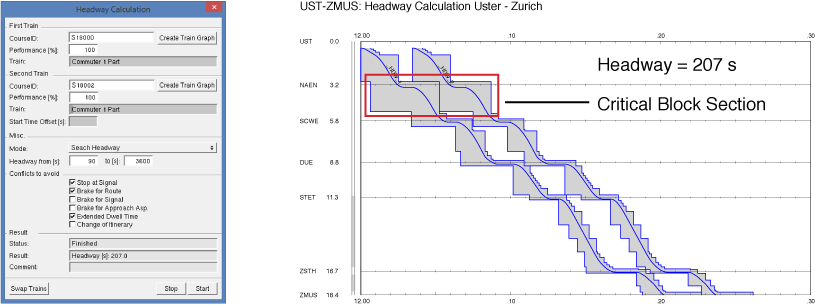
This graphic is also available as a PDF document.
Output data
After a simulation, OpenTrack offers a number of evaluations. Evaluations of a train, line or station are possible. For a train, OpenTrack offers diagrams such as acceleration vs. distance, speed vs. distance, and obstructions. For a line, there are evaluations in the form of diagrams of train movements, route occupation and line profiles. Every station produces output about all the trains that used it, including arrival, stopping and departure times.The user can view output data in a diagram, or export or evaluate it in a readable ASCII table.
The OpenTrack application
The OpenTrack application is available for the following operating systems: Windows 7 (32 and 64 Bit), Windows 8 (32 and 64 Bit), Windows 10 (32 and 64 Bit), Windows 11 (64 Bit) and macOS (64 Bit).The application is available in two versions. The full version of OpenTrack offers an unlimited number of running trains per simulation. The limit of the OpenTrack Light version is two trains per simulation.
Screenshots
The following images are examples of the graphical user interface of OpenTrack for different Windows versions and MacOSX.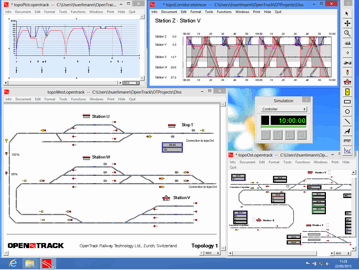 |
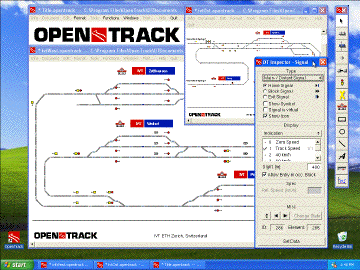 |
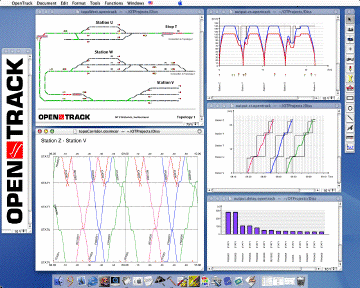 |
| Windows 8 | Windows XP | MacOS X |
Outputs
OpenTrack produces a number of outputs in text and/or graphic form.
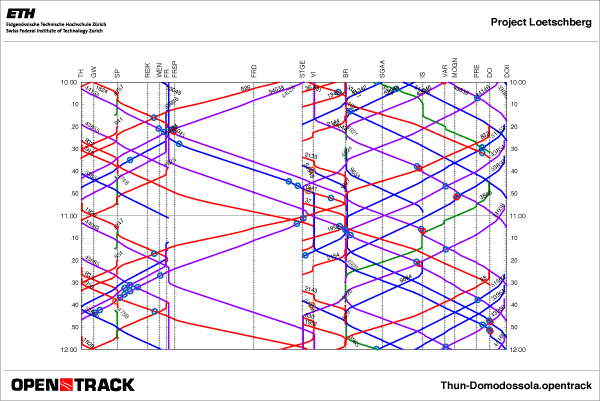
Train graph (offline and online visualization). This graphic is also available as a PDF document.
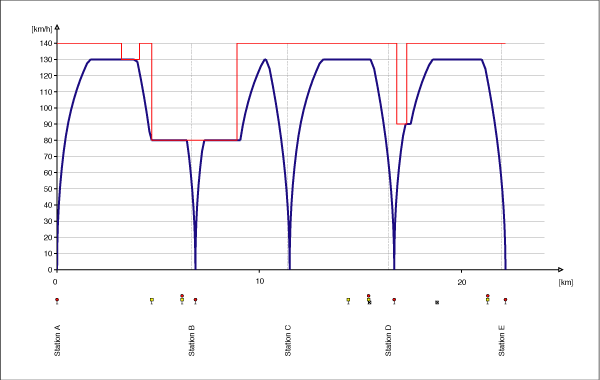
Speed/distance diagram
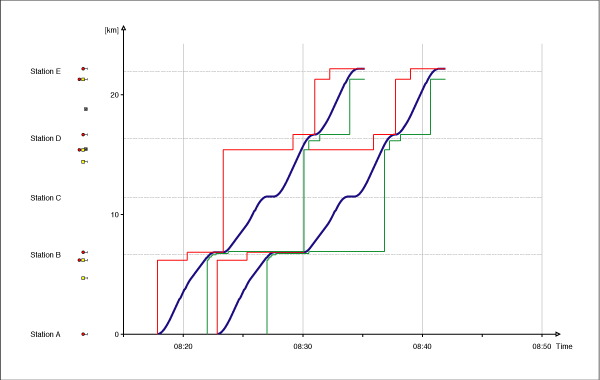
Distance/time diagram
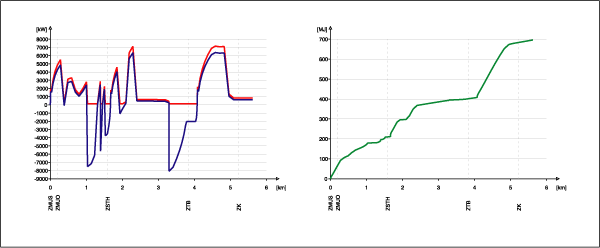
Power and energy output (red:Power in, blue: mech. Power, green: energy/distance-diagram)
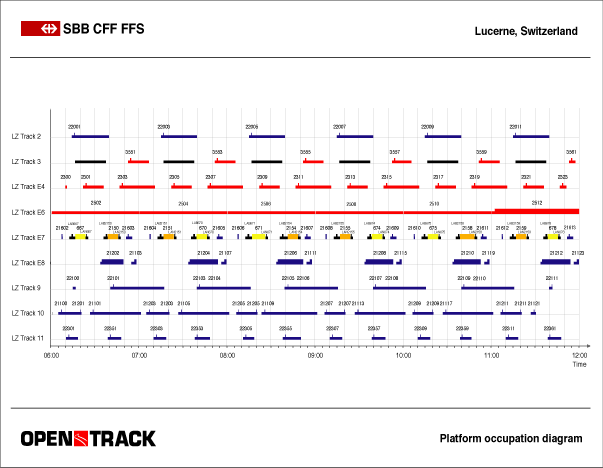
Occupation diagram
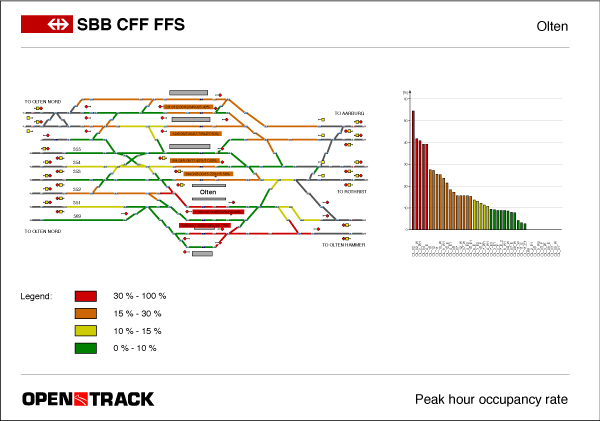
Occupation statistics (example: peak hour occupation percentage). This output is available as a PDF document.
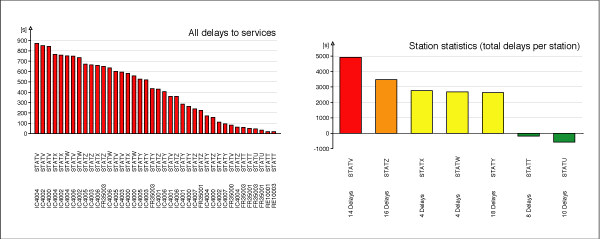
Delay statistics
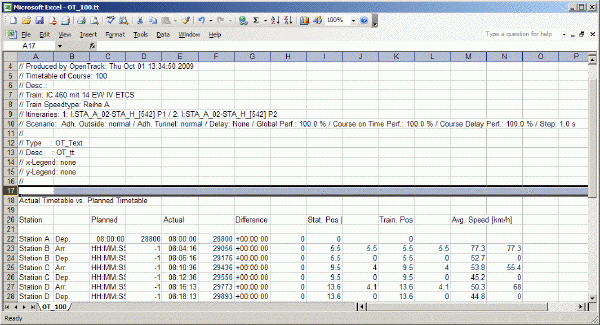
A user can obtain every output in the form of ASCII text, for import into Microsoft Excel for example.
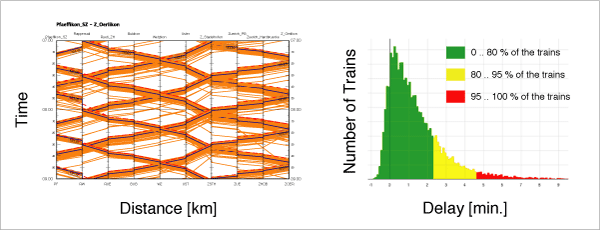
OpenTimeTable is able to visualize and analyze the outputs of multiple OpenTrack simulation runs.
OpenTrack API
OpenTrack offers an application programming interface (API) to connect other applications with OpenTrack. The other application can send standardized commands to OpenTrack and gets defined status messages back from OpenTrack. Technically, SOAP-Messages are exchanged via HTTP (SOAP over HTTP).

Possible applications:
- Implementation of customer-specific dispatching algorithms
- Comparison of new dispatching strategies
- Development and analysis of new concepts in train control (e.g. optimizing energy consumption, reducing delays and conflicts)
- In-depth evaluation of railway operations
A presentation of the OpenTrack API allows a better insight into the functionality of the API. (Download of the presentation - PDF, 2.9 MB). For further information on the OpenTrack API, please contact us or visit the OpenTrack API page.
Partners and customers
In the OpenTrack project, our company and the Institute for Transport Planning and Systems of the ETH Zürich co-operate with a number of partners from railway companies, the railway supply industry, consultancies and universities. The following companies and institutions use OpenTrack:
Railway operators and railway administrations
 |
Swiss Federal Railways, Switzerland | since 1999 | |
 |
REFER E.P., Rede Nacional Ferroviaria (National Railway Network), Portuga | since 2000 | |
 |
Rhaetian Railways, Switzerland | since 2002 | |
 |
TransAdelaide, Australia | since 2002 | |
 |
German Railways, Germany | since 2002 | |
 |
Finnish Rail Administration (RHK), Finland | since 2004 | |
 |
V/Line, Australia | since 2004 | |
 |
Ferrovie Nord Milano, Italy | since 2004 | |
 |
Northern Ireland Railways, UK | since 2005 | |
 |
BLS Loetschbergbahn AG, Switzerland | since 2005 | |
 |
ProRail, The Netherlands | since 2005 | |
 |
Circumvesuviana, Italy | since 2005 | |
 |
KiwiRail - New Zealand Railways Corporation, New Zealand | since 2008 | |
 |
NSB, Norway | since 2009 | |
 |
Ferrovie Nord Barese, Italy | since 2009 | |
 |
Jernbanedirektoratet (Norwegian Railway Directorate, former Jernbaneverket), Norway | since 2009 | |
 |
SZDC (Czech Railway Infrastructure Administration), Czech Republic | since 2009 | |
 |
Ferrovie del Sud Est, Italy | since 2009 | |
 |
SNCF (Société Nationale des Chemins de Fer Français), France | since 2009 | |
 |
Ferrovie del Gargano, Italy | since 2009 | |
 |
Victoria - Department of Transport, Australia | since 2010 | |
 |
FAL - Ferrovie Appulo Lucane, Italy | since 2010 | |
 |
FCU - Ferrovie Centrale Umbria, Italy | since 2010 | |
 |
ADIFSE - Administración de Infraestructuras Ferroviarias, Argentina | since 2010 | |
 |
RFI - Rete Ferroviaria Italiana, Italy | since 2010 | |
 |
Regione Umbria, Italy | since 2011 | |
 |
Ferrovie Emilia Romagna, Italy | since 2011 | |
 |
Queensland Rail, Australia | since 2012 | |
 |
Ferrocarrils de la Generalitat de Catalunya (FGC), Spain | since 2013 | |
 |
Auckland Transport, New Zealand | since 2014 | |
 |
Taiwan High Speed Rail Corporation, Taiwan | since 2014 | |
 |
Saudi Railway Company, Kingdom of Saudi Arabia | since 2014 | |
 |
Sitarail, Ivory Coast | since 2014 | |
 |
PKP Polskie Linie Kolejowe, Poland | since 2014 | |
 |
Aurizon, Australia | since 2015 | |
 |
Public Transport Authority (PTA), Australia | since 2016 | |
 |
SNCF - Innovation & Research, France | since 2016 | |
 |
NS - Nederlandse Spoorwegen, The Netherlands | since 2016 | |
 |
Ethiopian Railways Corporation (ERC), Ethiopia | since 2016 | |
 |
KTMB, Malaysia | since 2017 | |
 |
Grupo EFE, Chile | since 2017 | |
 |
Željeznice Republike Srpske (ŽRS), Bosnia and Herzegowina | since 2017 | |
 |
Metrolinx, Canada | since 2017 | |
 |
First Rail, UK | since 2017 | |
 |
Bangkok Airport Rail Link (ARL), Thailand | since 2017 | |
 |
SETRAG, Gabon | since 2018 | |
 |
Ferrocarriles del Sur (FESUR), Chile | since 2018 | |
 |
Empresa de Planejamento e Logística (EPL), Brazil | since 2018 | |
 |
AATE, Peru | since 2019 | |
 |
Sri Lanka Railways, Sri Lanka | since 2019 | |
 |
National Capital Region Transport Corporation (NCRTC), India | since 2019 | |
 |
VR Group, Finland | since 2019 | |
 |
Arriva, The Netherlands | since 2019 | |
 |
NHSRCL, India | since 2020 | |
 |
NAH.SH, Germany | since 2020 | |
 |
Ontario - Ministry of Transportation, Canada | since 2021 | |
 |
Zillertalbahn, Austria | since 2021 | |
 |
Salzburger Lokalbahn, Austria | since 2021 | |
 |
Operail, Estonia | since 2021 | |
 |
Kereta Api Indonesia (KAI), Indonesia | since 2023 | |
 |
Metlink, New Zealand | since 2024 | |
 |
RTRDA, Thailand | since 2024 | |
 |
ENEA - Italian National Agency for New Technologies, Energy and the Environment, Italy | since 2024 |
Metro and tram operators
 |
De Lijn, Belgium | since 2007 | |
 |
Metro Santiago, Chile | since 2008 | |
 |
TfGM (Transport for Greater Manchester), UK | since 2009 | |
 |
RATP (Régie autonome des transports Parisiens), Paris, France | since 2009 | |
 |
Guangzhou Metro, China | since 2010 | |
 |
Shenzhen Metro, China | since 2011 | |
 |
MetroRio, Brazil | since 2012 | |
 |
Transport for London, UK | since 2013 | |
 |
Beijing Subway, China | since 2013 | |
 |
Macau LRT, Macau | since 2014 | |
 |
Move São Paulo, Brazil | since 2014 | |
 |
Metro de Lima, Peru | since 2014 | |
 |
Sporveien Oslo, Norway | since 2014 | |
 |
MTR Corporation, Hong Kong | since 2014 | |
 |
Seoul Metro, Korea | since 2015 | |
 |
Metro de Medellín, Colombia | since 2016 | |
 |
Helsinki Region Transport - HSL, Finland | since 2016 | |
 |
Land Transport Authority - LTA, Singapore | since 2016 | |
 |
ATM, Italy | since 2017 | |
 |
RET, The Netherlands | since 2017 | |
 |
Bangkok Expressway and Metro (BEM), Thailand | since 2017 | |
 |
SMRT Corporation Ltd, Singapore | since 2018 | |
 |
Hamburger Hochbahn, Germany | since 2018 | |
 |
Metroselskabet and Hovedstadens Letbane , Denmark | since 2018 | |
 |
Metropolitano de Tenerife, La Laguna – Santa Cruz de Tenerife, Spain | since 2018 | |
 |
Mass Rapid Transit Authority of Thailand, Thailand | since 2019 | |
 |
Stadtwerke München, Germany | since 2020 | |
 |
Metro São Paulo, Brazil | since 2021 | |
 |
City of Edmonton, Canada | since 2021 | |
 |
Transdev, Brazil | since 2022 | |
 |
The Port Authority of New York and New Jersey, USA | since 2022 | |
 |
Verkehrsgesellschaft Frankfurt am Main (VGF), Germany | since 2022 | |
 |
NTA Tel Aviv, Israel | since 2023 | |
 |
Toronto Transit Commission (TTC), Canada | since 2023 | |
 |
traffiQ, Germany | since 2023 |
Railway supply industry / mining industry
 |
Siemens AG, Switzerland / Germany / Australia | since 1999 | |
 |
Infraspeed, The Netherlands | since 2002 | |
 |
Bombardier Transportation , USA / Sweden / UK | since 2006 | |
 |
Consorzio TAT, Switzerland and Implenia AG, Switzerland | since 2007 | |
 |
Fortescue Metals Group Ltd, Australia | since 2010 | |
 |
Vale, Mozambique | since 2011 | |
 |
Hyundai Rotem, Korea | since 2011 | |
 |
Alstom Transport, Italy / France / Belgium / Spain / Canada / Australia | since 2012 | |
 |
ABB - Asea Brown Boweri S.A., Spain / Brazil | since 2012 | |
 |
Posco Engineering Co. Ltd., Korea | since 2013 | |
 |
Thales, Portugal / Denmark | since 2013 | |
| ICONTROLS, Korea | since 2014 | ||
 |
Toshiba Corporation, Japan | since 2014 | |
 |
Hitachi Ltd., R&D, Japan | since 2015 | |
 |
PSI Transcom, Germany | since 2016 | |
 |
Shinwoo ENG Co., Ltd., Korea | since 2016 | |
 |
DAEATI Co., Ltd., Korea | since 2016 | |
 |
Meidensha Corporation, Japan | since 2016 | |
 |
CRRC Corporation Limited, China | since 2016 | |
 |
BHP Billiton, Australia | since 2017 | |
 |
Len Railway Systems, Indonesia | since 2018 | |
 |
Downer Group, Australia | since 2020 | |
 |
UK Power Networks, UK | since 2023 | |
 |
Stadler AG, Switzerland | since 2023 | |
 |
Linxon, Philippines | since 2025 |
Consultancies
 |
SMA und Partner AG, Switzerland | since 1999 | |
 |
ETC Transport Consultants GmbH, Germany | since 1999 | |
 |
Pöyry Infra AG, Switzerland | since 1999 | |
 |
REFER Engineering, Portugal | since 2000 | |
 |
EBP, Switzerland | since 2001 | |
 |
NET engineering, Italy | since 2001 | |
 |
Institut für Bahntechnik (Inst. for Railway Engineering), Germany | since 2001 | |
 |
Plateway Pty Ltd, Australia | since 2001 | |
 |
Movares Nederland, The Netherlands | since 2003 | |
 |
SNC-Lavalin Rail & Transit, UK / Sydney, Australia / Vancouver, Canada | since 2004 | |
 |
Tyréns AB, Sweden | since 2005 | |
 |
COWI, Denmark / Norway / Poland | since 2005 | |
 |
Haskoning, The Netherlands | since 2005 | |
 |
Egis Rail, France / Serbia | since 2006 | |
 |
TTK - TransportTechnologie-Consult Karlsruhe GmbH , Karlsruhe, Germany | since 2007 | |
 |
Norconsult AS, Norway | since 2007 | |
 |
Laboratorio di Ingegneria Ferroviaria e Traffico, Italy | since 2008 | |
 |
IBV Hüsler AG, Switzerland | since 2008 | |
 |
TPS Transport Planning Service, Italy | since 2008 | |
 |
Booz Allen Hamilton, USA | since 2008 | |
 |
Geodata SpA, Italy | since 2008 | |
 |
Ramboll, Sweden / Finland / Denmark / Germany | since 2008 | |
 |
Worley Australia, Australia | since 2008 | |
 |
Emch + Berger AG, Switzerland | since 2009 | |
 |
Aurecon, Australia | since 2009 | |
 |
RINA Consulting (formerly D'Appolonia), Italy | since 2009 | |
 |
DB International, Germany | since 2009 | |
 |
SIYUAN (China Railway Siyuan Survey And Design Group Co.), China | since 2009 | |
 |
Italferr, Italy | since 2009 | |
 |
Calibre Rail, Australia | since 2009 | |
 |
ILF - Consulting Engineers, Switzerland | since 2010 | |
 |
TSD Consulting Services, South Africa | since 2010 | |
 |
Rail Systems Engineering Sdn. Bhd., Malaysia | since 2010 | |
 |
Millennia Systems, Inc., USA | since 2010 | |
 |
JG Afrika, South Africa | since 2011 | |
 |
Aurecon, South Africa | since 2011 | |
 |
WSP, Australia / Hong Kong / USA / Canada / Finland / UK | since 2011 | |
 |
Főrmterv, Hungary | since 2011 | |
 |
SYSTRA, France / Australia / USA | since 2011 | |
 |
The Third Railway Survey and Design Institute, China | since 2011 | |
 |
The China Railway Eryuan Engineering Group Co. Ltd., China | since 2011 | |
 |
CH2M, USA | since 2011 | |
 |
SIGNON, Germany | since 2012 | |
 |
Vecturis, Belgium | since 2012 | |
 |
Ingérop, France / Spain | since 2012 | |
 |
Valbek SK, spol. s.r.o., Slovakia | since 2012 | |
 |
Engenicom, Australia | since 2012 | |
 |
Setec Ferroviaire and Setec its, France | since 2012 | |
 |
Parsons, Canada | since 2013 | |
 |
Yapi Merkezi Insaat, Turkey | since 2013 | |
 |
taktici.cz, s.r.o., Czech Republic | since 2013 | |
 |
SENER, Spain / Mexico | since 2013 | |
 |
Hatch, Canada / South Africa | since 2013 | |
 |
Nippon Koei Co., Ltd., Japan | since 2013 | |
 |
China Railway Engineering Consulting Group Co., China | since 2014 | |
 |
Aarvee Associates, India | since 2014 | |
 |
Sintra, Mexico | since 2014 | |
 |
Beijing Urban Construction & Development Group Co., China | since 2014 | |
 |
Paragon Tecnologia Ltda, Brazil | since 2014 | |
 |
TRENECON COWI, Hungary | since 2014 | |
 |
BBF Sp. z o.o., Poland | since 2014 | |
 |
Beijing Rail and Transit Design and Research Institute, China | since 2014 | |
 |
Sweco, Sweden / Finland | since 2014 | |
 |
Instytut Kolejnictwa, Poland | since 2014 | |
 |
Raul V. Bravo + Associates, Inc., USA | since 2014 | |
 |
WYG Consulting, Poland | since 2014 | |
 |
Idom, Spain | since 2015 | |
 |
AECOM, Australia / Canada | since 2015 | |
 |
TRENOLab, Italy | since 2016 | |
 |
Tractebel Engie, Belgium | since 2016 | |
 |
Mott MacDonald, USA | since 2016 | |
 |
Mota-Engil, Portugal | since 2017 | |
 |
SUDOP BRNO, Czech Republic | since 2017 | |
 |
RSE (Rail Solution Engineering) Co. Ltd., Korea | since 2017 | |
 |
VTD Rail Consulting, USA | since 2017 | |
 |
Gannett Fleming, Canada | since 2017 | |
 |
Signalplan AG, Switzerland | since 2017 | |
 |
Ricardo Rail, Korea / Australia | since 2017 | |
 |
Korea Railroad Research Institute, Korea | since 2017 | |
 |
CECI Engineering Consultants City, Taiwan | since 2017 | |
 |
SETIRAIL, Algeria | since 2018 | |
 |
RING Engineering, Hungary | since 2018 | |
 |
Sharma & Associates, Inc., USA | since 2018 | |
 |
Arup, UK / Hong Kong /Canada | since 2018 | |
 |
Dopravní projektování, Moravská, Czech Republic | since 2018 | |
 |
Seowoo Construction Industry, Korea | since 2019 | |
 |
DOHWA Engineering Co., Ltd., Korea | since 2019 | |
 |
Aselsan, Turkey | since 2019 | |
 |
MHPM Company Ltd, Thailand | since 2019 | |
 |
HDR, USA / Canada | since 2019 | |
 |
HNTB Corporation, USA | since 2019 | |
 |
TRN TARYET, Spain | since 2019 | |
 |
Minconsult, Malaysia | since 2020 | |
 |
Jacobs, Malaysia | since 2020 | |
| Baicons, Romania | since 2020 | ||
 |
Australis Rail Consulting, Australia | since 2020 | |
 |
KSP Consulting, New Zealand | since 2020 | |
 |
Sagasta, Czech Republic | since 2020 | |
 |
Kiewit, USA | since 2020 | |
 |
Oriental Consultants Global Co., Ltd., Japan | since 2020 | |
 |
Beijing Municipal Engineering Research Institute, Beijing, China | since 2021 | |
 |
FLOU, Finland | since 2021 | |
 |
Moravia Consult Olomouc (MCO), Czech Republic | since 2022 | |
 |
EXprojekt, Czech Republic | since 2022 | |
 |
ONxpress, Canada | since 2023 | |
 |
Network Rail Consulting, UK | since 2023 | |
 |
Eurotransproject, Bulgaria | since 2023 | |
 |
CONiiSA, Mexico | since 2024 | |
 |
SGS, Mexico | since 2024 | |
 |
CTCI, Taiwan | since 2024 | |
 |
CDM Smith, USA | since 2024 | |
 |
Railectric, Switzerland | since 2024 | |
 |
JMDR, Australia | since 2024 | |
 |
Suter Bahnkompetenz, Switzerland | since 2024 | |
 |
DNV, Korea | since 2024 | |
 |
SUDOP PRAHA, Czech Republic | since 2025 | |
 |
Elektrizace železnic Praha, Czech Republic | since 2025 | |
 |
TYLin, Spain | since 2025 |
Universities and research institutes
Documents / downloads
PDF files related to OpenTrack
- OpenTrack Brochure in English, German, French, Spanish, Portuguese, Czech, Russian, Bulgarian, Serbian, Malay, Indonesian or Tamil (PDF-Format).
- Short Description about OpenTrack (six pages) in English, German, French, Spanish, Czech , Russian, Bulgarian, Serbian or Indonesian (PDF Format).
- Abstract (PDF format) of dissertation number 14281, “Object oriented modeling in railways”, which describes the basics of OpenTrack. Swiss Federal Institute of Technology (2 pages, German and English).
- OpenTrack-Logo (ZIP Format): This file contains two different OpenTrack logos in the .EPS, .GIF and .BMP formats.
Article in the journal "Güterbahnen" (Freight Railways)
Issue 2/2003 of the journal Güterbahnen included the article Ermittlung und Leistungsfähigkeit einer Werkbahn mit OpenTrack (Investigations on the Capacity of an Industrial Railway with OpenTrack). We would be pleased to send you a free copy of the article.
Railway Gazette 04/2006
 |
In issue April 2006 of the journal Railway Gazette the authors T. Salt and K. Mears from Interfleet Technlology published an article "Automation gets the most out of mining railway infrastructure". We would be pleased to send you a free copy of the article.
Australian Government: North-South Rail Corridor Study
 |
The North-South Rail Corridor Study (where OpenTrack was used as one of the tools) has comprehensively examined the adequacy, given the current major infrastructure investment programme, of the existing Melbourne-Sydney-Brisbane rail corridor to meet future freight demand.The study examined different options, including possible enhancements to the coastal line, as well as alternative inland routes. Key issues included infrastructure links, engineering, environmental, urban and regional planning issues. A financial and economic analysis was also undertaken on each of the route options.
Railway Gazette 07/2008
 |
Sharing tracks in Sydney is the title of an article published in the Railway Gazette 07/2008 by Ian Imrie from Plateway. The article describes the complexity of sharing tracks between freight and passenger trains in the Sydney area.
Supporting the study, the two Swiss Tools Viriato and OpenTrack were used with success.
Presentation to RTSA Wellington (NZ)
The company Plateway from Clyde, Australia gave a presentation about OpenTrack and simulation tools in general in June 2012 to RTSA in Wellington.Report in the journal Logistyka
In 2014, the journal Logistyka published an article about the railway simulation using OpenTrack. The report can be downloaded as a PDF file.The Art of creating a Timetable
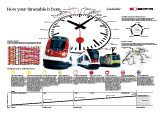 |
Swiss Railways (SBB) published a paper paper named How the timetable is born - From initial studies to the daily timetable. It describes the role of OpenTrack in the timetable planning process of SBB. The paper can be downloaded as a PDF file.
Presentation at the 1st European Rail Simulation Technlolgy Forum
 |
David Koopman from Royal HaskoningDHV (The Netherlands) gave a presentation about OpenTrack in November 2016 at the 1st European Rail Simulation Technlolgy Forum in Amsterdam. The presentation can be downloaded as a PDF file.
Metro Report 12/2016
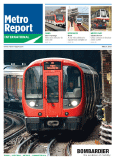 |
Eric Cosandey and Pascal Joris published the aricle Using simulation to predict the impact of upgrades in the 12/2016 issue of the publication Metro Report.
University of Toronto:Capacity Analysis of a Complex Railway Station Using Integrated Crowd and Transit Simulation: A Case Study of Toronto’s Union Station
 |
Yishu (Roy) Pu presented his MASc thesis as part of the UT-ITE Seminar Series on September 8, 2017. Yishu Pu kindly shared a PDF of his presentation file here: Capacity Analysis of the Union Station Rail Corridor Using Integrated Rail and Pedestrian Simulation.
Doctoral Thesis by Adrian Wagner at TU Vienna
 |
Adrian Wagner made intensive use of OpenTrack in his doctoral thesis Influence of Train and Traffic Control on Railway Station Capacity (April 2024).
Usage of the Headway Calculator
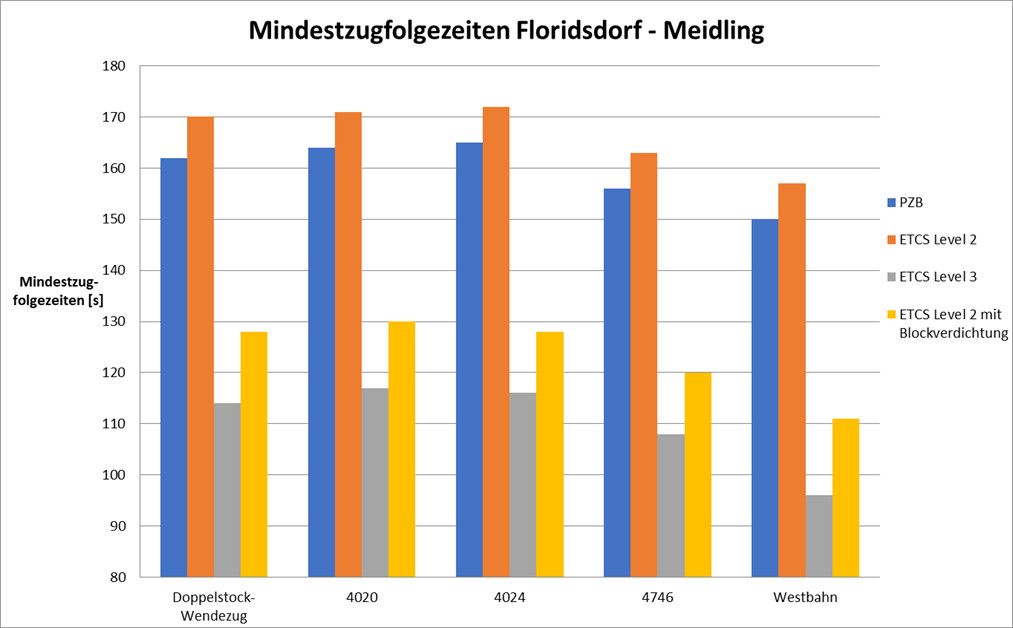 |
In the April 2020 issue of the magazine “Signalling + Datacommunication” the article (PDF) “Headways in ETCS Levels 2 and 3 on the main urban railway line in Vienna” has been published. For the calculation of headways the Headway Calculator of OpenTrack has been applied.
ETCS Level 2 HTD (Hybrid Train Detection): Capacity Analyses using an OpenTrack Simulation
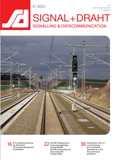 |
In his article Capacity analyses for the EKA line using OpenTrack Simulation (published in the June 2025 issue of Signal & Draht magazine), Markus Helelä of Ramboll Finland describes in detail how an ETCS Level 2 HTD (Hybrid Train Detection) line is modeled and simulated in OpenTrack.
Please contact us if you are interested in this topic.
OpenPowerNet - Simulation of Railway Power Supply Systems
 |
Presentation about the Simulation of Railway Power Supply Systems (Co-Simulation of OpenPowerNet with OpenTrack) (PDF, 2.7 MB, Download).
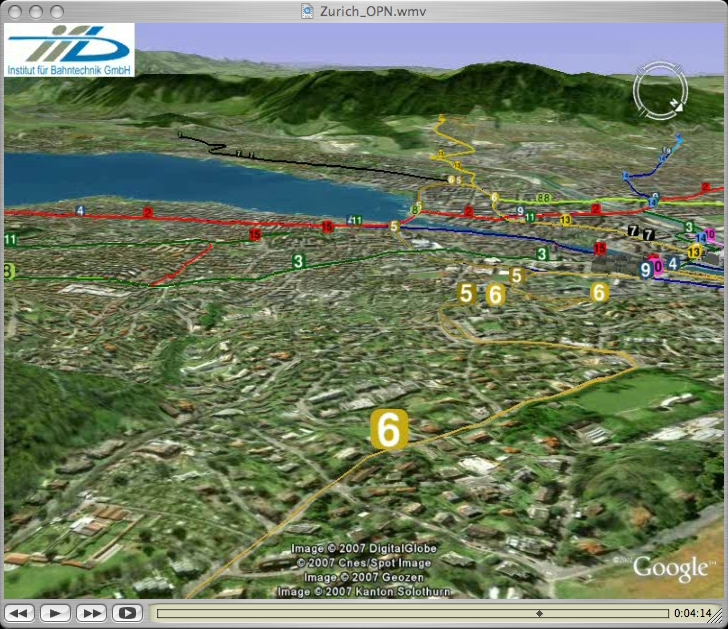 |
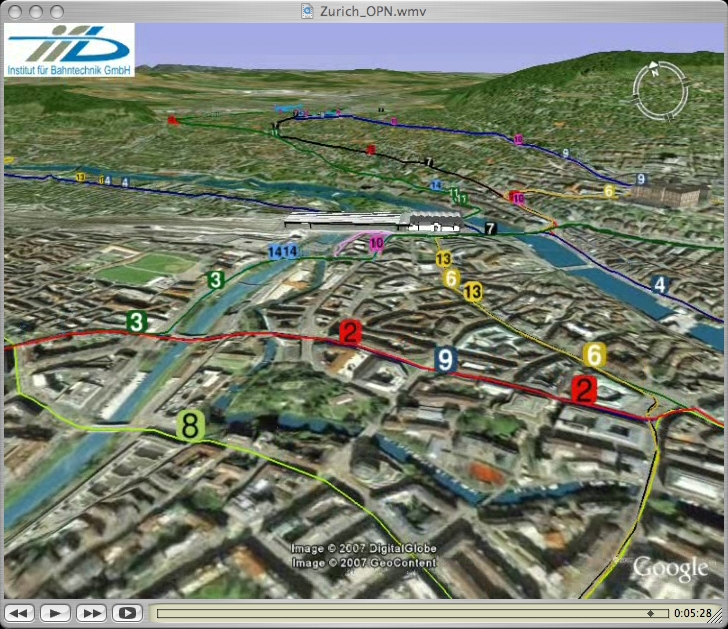 |
Two screenshots from the OpenPowerNet project for Zurich (simulation of tram system Zurich) after the postprocessing of the OpenTrack output data to Google Earth. © 2008 by IfB.
OpenPowerNet Video: Download (.mp4-Format)
More reports and presentations
You’ll find more reports on the use and development of OpenTrack in the German section of our web page and more presentations (in English) in our user workshop section.OpenTrack Videos
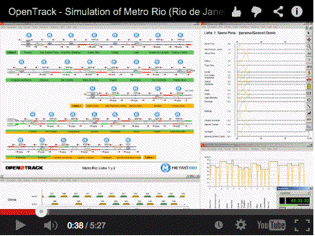
The following links require Apple Quicktime Player or Windows Media Player. Otherwise the the videos can be watched on YouTube.
- Process animation directly on the track layout (1 MB) (.AVI-Format)
- Process animation: The fictitious example Olten (900 kB) (.AVI-Format)
- Animated train graph (400 kB) (.AVI-Format)
- User friendly timetable editing directly within the train graph (388 kB) (.AVI-Format)
- OpenPowerNet-Video (.mp4-Format)


Watch all the OpenTrack-Videos on YouTube.
OpenTrack on LinkedIn
Follow us on LinkedIn:
OpenTrack Railway Technology Ltd. on LinkedIn
OpenTrack - Simulation of Railway Networks on LinkedIn
Further information
For further information on OpenTrack, please contact:OpenTrack Railway Technology Ltd
Gubelstr. 28
CH - 8050 Zürich
Switzerland
Phone: + 41 - 44 - 310 19 90
Fax: + 41 - 86 - 044 310 19 90
E-Mail: info@opentrack.ch
